|
Husaren (Light Cavalry)
Pelzmütze 1843 - 1915 |
The colorful uniforms of the Husaren (Light Cavalry) first appeared in 1721 when a blue Kollet (a waist-length jacket with tails) with rows of ornamental braiding on the chest was introduced with a tall, cylindrical piece of headgear called a "Tschako" which was common to most troops in the Napoleonic period. Preußen Husaren emulated the famous Hungarian light cavalry, as Husar and Attila are actually Hungarian words which were adopted by many nations, Preußen included.
Line and Leib Husaren Regiments wore a tall cylindrical helmet called "Flügelmütze" (winged cap) which also coincided with a new uniform known as the Attila. The "Flügelmütze" remained in use for Line and Leib Regiments until 1850 when it was replaced by Pelzmütze already in use by the Garde Husaren Regiment. |  | |
| |
 | 1843 - 1850
In 1843 the Garde Husaren Regiment were first introduced with a hair-covered form of headdress called a Pelzmütze (literally a fur cap) which is commonly referred to as a Busby. *Note* The plural of Pelzmütze is Pelzmützen.
The "Flügelmütze" remained in use for Line and Leib Regiments until 1850 when it was replaced by Pelzmütze already in use by the Garde Husaren Regiment. These two Husar from the Leib-Garde Husaren Regt (Potsdam) Garde-Korps show the exceptional height of the M1843 Pelzmütze.
Photo used with the kind permission of Photo courtesy of Sergio Semino of
militaria-online.de.
Below is an abbreviated list of contingents that utilized some form of Pelzmütze after 1843:
- 1843 - Preußen Garde Husaren;
- 1850 - All other Preußen Husaren Regts;
- 1867 - Braunschweig; and
- 1876 - Sachsen (Saxony).
| |
 | 1860
In 1860 Preußen Husaren Regiments adopted a new Pelzmütze. All Line Regiments carried a "wave" pattern Bandeau (ribbon) in German silver or brass that dipped down in the center, with the motto "MIT GOTT FÜR KOENIG UND VATERLAND" (With God For King And Fatherland). The Preußen Garde Husaren Regt at this time adopted a new Wappen (front plate) which also incorporated the new Fatherland motto and the date "1860".
The Wappen (insignia) on Pelzmütze range widely and are best illustrated in the color Husaren plates at the top or bottom of this page.
The color of the Kolpak (cloth bag) which hangs on the left side of the Pelzmütze was also specific to the Regiment. Please see the "Uniform Details for all Husaren Regiments" link at the top or bottom of this page for details.
| |
Feldzeichen
Contingents that utilized a Pelzmütze wore a variety of Feldzeichen (a cloth-covered wooden badge in the state colors) which was worn on top of the Pelzmütze. The following Contingents had Husaren Regiments in their order of battle:
- Braunschweig
- Preußen
- Sachsen (Saxony)
The original Feldzeichens in the photo to the right are in the same order as the list above.
|
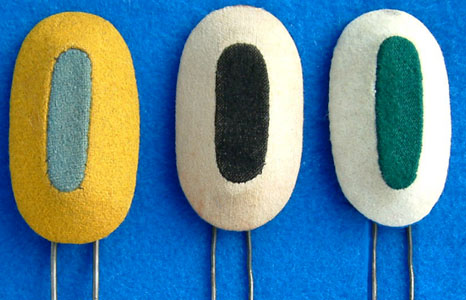 |
|
Eigentumsstück Feldzeichen
Eigentumsstück (privately purchased) Feldzeichen were normally of a looped cord. Collectors often refer to the looped cord Feldzeichen as "NCO", when there appears to be no proof or documentation that it has anything to do with it being an NCO. It appears constantly in period photos of Ulanen and Husaren with the ranks of Private which indicates that looped cord Feldzeichen were just a Eigentumsstück (private-purchase) "upgrade" and not dependant on rank.
|
 | Officer's Feldzeichen
Officer Feldzeichen were made from hand-embroidered bullion in silver (Preußen and Sachsen) or gold (Braunschweig) with velvet centers in the contingent colors.
The example shown here is Preußen.
The bullion officer Feldzeichen was also authorized to be worn by the highest level of NCOs, the Wachtmeister and Vizewachtmeister. The only other rank that could wear the bullion Feldzeichen was the Fähnrich (Officer-Candidate NCO) after passing exams.
|
|
1894
In 1894 the Pelzmütze received the infantry pattern Model 1891 posts for the chinscales and in 1897 all Pelzmützen were updated with the new Reich's Kokarde to be worn on the right side. Issued Pelzmütze were a very tight black-dyed seal hide.
|
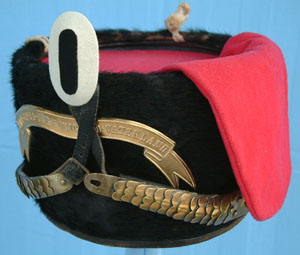 Click to Enlarge
| |
 Click to Enlarge
| The seal hide of issued (and often privately-purchased) Pelzmütze was stretched over a frame of bamboo on the upper half and of corrugated stiffened burlap on the lower half. The stiffened burlap can be found in a variety of colors, such as green, black, white etc.
|
|
| The liners of issued Pelzmützen were very distinctive being heavy leather with pointed "tongues" perforated at the ends for a leather string to adjust the fit. This unique pattern of liner was used in issued Pelzmütze for the entire life of the helmet from 1850 to 1915.
|
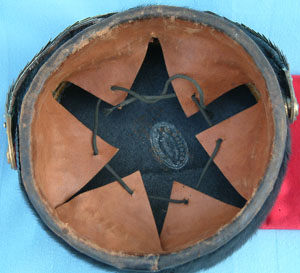 Click to Enlarge
|
|
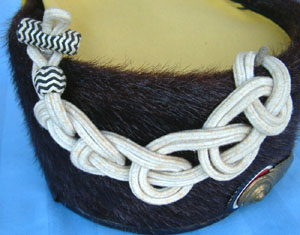 Click to Enlarge
| Fangschnur
The Fangschnur (securing cord) was attached to the top of the Pelzmütze with a toggle for Mannschaften and a hook for officer and (often) private purchase.
The Fangschnur were then looped around the neck of the wearer which prevented loss of the Pelzmütze in battle. When not around the neck, the Fangschnur were braided into loops and hung on the right side of the Pelzmütze as show in the photo to the left. | |
| The toggle and slide on Fangschnur were white for Mannschaften (Other Ranks), state colors & white for NCOs. On the NCO Fangschnur example shown above, the white & black toggle and slide is for Preußen NCOs. All officers wore silver bullion with flecking in their state colors for officers. For example: officer Fangschnur for Preußen officers were silver with black flecking. |
Officer Pelzmütze
Officer Pelzmützen tended to be much larger in volume as illustrated by this period photo of a Garde Husaren Regiment Officer wearing an officer's Pelzmütze. Officer Pelzmützen were more of a cap than a helmet, being soft-sided unlike the rigid bodies of the issued Pelzmütze. Officer Pelzmütze were lined with cloth (usually silk) and utilized the "squared finger" liners until 1880 when the internal leather sweatband and skull-cap came into use. All officer Pelzmütze were covered in thick brown otter fur until 1912 when the covering was replaced by grey opossum fur. The only exception is Husaren Regt Nr 17 from Braunschweig, where all officers wore black bear fur Pelzmützen. |  Photo used with the kind permission of
Thomas Helmlick |
|
Parade Plumes
For parades, Mannschaften and officers wore parade plumes inserted behind the Feldzeichen. |  |
|
| Mannschaften wore a Haarbusch (hair bush) parade plume made from white horse hair. From 1843 to 1903 the Haarbusch was vertical for the bottom third, then fell down on the right side, similar to a Ulanen Tschapka Haarbusch. In the 1903 the Mannschaften Haarbusch was changed so that it was completely vertical. Officers wore a Federbusch (Feather bush) parade plume which was made from feathers. The colors reflected the contingent i.e. Preußen officer's Federbusch had black feathers on the bottom, white on top. |
 Click to Enlarge
| Privately Purchased Pelzmütze
According to period catalogues, Fähnriche and Fahnenjunker (two forms of officers cadet) were allowed to purchase bear fur Eigentumsstück (Private purchase) Pelzmütze. This seems to have also been tolerated for privately-purchased Pelzmütze for lower ranks as they range in color from black to a very dark brown (almost black) and do not exhibit the smooth-tight hair of a seal hide issued Pelzmütze as evidenced by period photographs.
|
|
| The example shown here is a Mannschaften (Other Ranks) privately purchased Pelzmütze for Husaren-Regt. Königin Wilhelmena der Niederlande (Hannoversches) Nr.15. It is made from seal hide, but the hair is the natural dark-brown color and has not been dyed black. |
| Show here is the squared leather tongue liner commonly encountered on Eigentums-helm and referred to as the "Extra" pattern. The leather is a higher quality and it was felt that this style of liner afforded more comfort. This pattern of liner was also worn by officers until 1880.
|
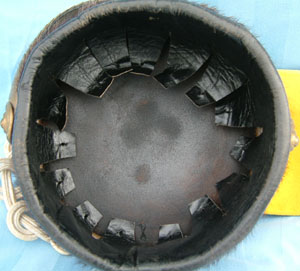 Click to Enlarge
|
|
 | Leib Husaren
Leib-Husaren Regt. Nr.1 and Leib-Husaren Regt. Nr.2 wore a Neusilber (nickel-silver) Totenkopf (deaths-head) from 1809 to 1918. Some references claim that the Mannschaften (other Ranks) Bandeau of the Leib Husaren always curved up and around the Totenkopf, while the officer's Bandeau was the standard line Husaren "wave" pattern Bandeau that dipped down in the center. |
|
| Unfortunately, period photographs do not support this as a "rule". As shown in the photo above, Mannschaften (Other Ranks) Leib Husaren Pelzmütze are found with both standard line Husaren "wave" pattern Bandeau that dipped down in the center, or with the distinctive Leib Husaren pattern which curved up and around the Totenkopf. |
Further evidence that Mannschaften Leib Husaren Pelzmütze are occasionally found with standard Line Husaren "wave" pattern Bandeau that dipped down in the center, and not just the distinctive Leib Husaren pattern which curved up and around the Totenkopf, is this photo taken during the First World War of an American soldier joking with the camera.
The caption reads "Helmet of Crown Prince's Death Head Hussars". |
 Photo used with the kind permission of
Peter Whamond |
|
 | As Kaiser, his Majesty Wilhelm II typically wore a general's Pickelhaube and uniform of the unit he would visit. The exception, was when he dressed as a Leib Husar. The Attila he wore was always a General's rank, but rather than an officer's Pelzmütze of brown otter fur (until 1912) or grey opossum fur (after 1912), Wilhelm always wore a Mannschaften pattern Leib Husaren black Pelzmütze.
Note that although he wore an officer's Feldzeichen, the "Fatherland" Bandeau is clearly the Leib Husaren Mannschaften pattern which curves up around the Totenkopf. |
|
Braunschweigisches Husaren-Regt. Nr.17
Issued Mannschaften (Other Ranks) examples from Husaren Regt Nr. 17 from Braunschweig are black-dyed seal hide but HR17 was the only regt where a private purchased Pelzmütze could be bear hide. HR17 was also the only regiment authorized to wear yellow Fangschnur. The unique gilt Bandeau was authorized for all ranks in 1867 and carried the battle honours of "PENINSULA-SICILIEN-WATERLOO" to commemorate the Regiment's actions in 1812-1814 in Spain and 1815 at Waterloo. In 1873 "MARS LA TOUR" was added for this battle during the Franco-Preußen war. | 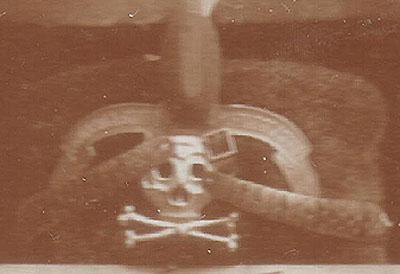 |
|
| On 17 September 1883, the Braunschweig pattern Totenkopf was authorized to be worn by Braunschweigisches Husaren-Regt. Nr.17 on their Pelzmütze. Unlike the Preußen Leib-Husaren pattern Totenkopf which was identical for all ranks, the Braunschweig pattern Totenkopf came in two distinct patterns: a flat issued pattern for Mannschaften (Other Ranks) and a private-purcahse pattern. The private-purcahse (officer's) Totenkopf, like the one worn by Braunschweigisches Infanterie-Regt. Nr.92, was three-dimensional with much more depth, compared to the issued Totenkopf, which was quite flat. |
 | Officer's Pelzmütze of Husaren-Regt. Nr.17
The officer's Pelzmütze of the Braunschweigisches Husaren-Regt. Nr.17 was unique, in that it was made from bear hide and rather than the standard officer-quality curved mounted-pattern chinscales with the pattern of alternating scales with rounded ends of 3 then 2, then 3, the chinscales on officer's Pelzmütze of Husaren-Regt. Nr.17 had five rounds on the end of each scale. Additionally, the Rosettes that held the chinscales onto the Pelzmütze were lion heads.
This photograph is of Herzog Ernst August von Braunschweig the Commander-in-Chief of Braunschweigisches Husaren-Regt. Nr.17 and husband of Princess Victoria Louise. (1887-1953). |
|
| Gallery
|

Leib-Garde
Husaren Regt
|

Leib-Husaren Regt.
Nr.1 or 2
|
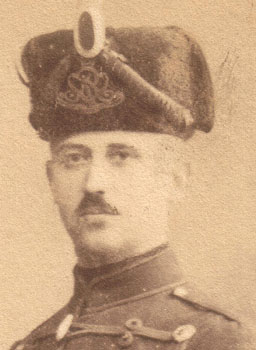
Husaren-Regt. König Wilhelm I
(1.Rheinisches) Nr.7
|
| |

Husaren-Regt. Königin Wilhelmena der Niederlande (Hannoversches) Nr.15
|
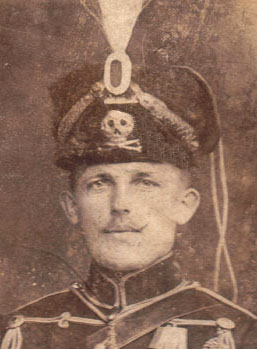
Braunschweigisches
Husaren-Regt.
Nr.17
|
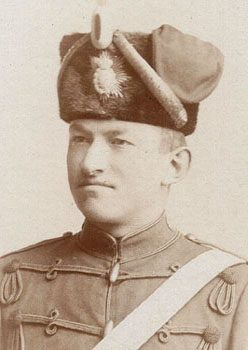
Kgl. Sächs.
Husaren-Regt
18, 19, or 20 |
| |
Reserve Husaren
Reserve Pelzmütze carried a large Landwehr cross instead of the Bandeau for Preußen and Braunschweig Husaren, or superimposed on the Wappen (front plate) for Sachsen (Saxon) Husaren. As a general rule, the cross replaces the Bandeau with the contingent's motto, but exceptions exist, and photographs indicate that occasionally the Bandeau and the Landwehr cross were worn together.
This extremely rare photograph shows a Reserve Husaren from Braunschweigisches Husaren-Regt. Nr.17 (Braunschweig) X Armee Korps. The Distinctive Braunschweig Totenkopf is worn, but the Fatherland Bandeau has been replaced by a large Landwehr cross. |  |
|
 Photo used with the kind permission of
Stephen Case-Pall | Leib-Husaren Regt. Reserve
Reserve officers of the Leib-Husaren Regiments had no room on the Pelzmütze due to the large Preußen Totenkopf, so in lieu of the Fatherland Bandeau a Landwehr cross was worn on the officer's Feldzeichen. |
|
1914
Beginning in 1914, all arms received Ersatz-Helme (substitute helmets) until helmet supplies could meet demand. Ersatz (substitute) Pelzmützes were produced from Filz (rabbit felt) or cloth covered stiffened paper until leather supplies could meet demand. Surviving original examples are found with either pre-1915 brass or silver fittings, or with grey steel M1915 fittings. This wonderful photo shows a Husar from a Leib Husaren Regt wearing a Filz Ersatz Pelzmütze with an issued cloth Überzug (cover).
To reduce the reflection of the brass or silver fittings, all ranks were first issued with cloth Überzug (helmet cover) in 1892. In 1915 the issued covers were modified to allow the leather chinstraps to pass through the sides. |
 Photo used with the kind permission of
Robin Lumsden |
|
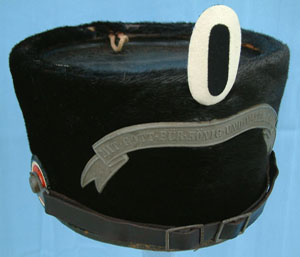 Click to Enlarge
| 1915
In accordance with the 1915 regulations issued Pelzmütze would no longer use brass or silver. Husaren Mannschaften (Other Ranks) Pelzmütze continued to be dyed seal hair but would now only have grey oxidized steel fittings for all Regiments and the brass chinscales were replaced with a black leather leather chinstrap on M1891 mounts. Issued Pelzmütze such as this example were often worn without the Kolpak (cloth bag). Wartime examples are often encountered with the pre-1915 silver or brass Wappen or Bandeau painted grey to utilize existing stocks.
|
|
| A rather "well-fed" NCO of a Line-Husaren Regt wearing a M15 Pelzmütze with a M1910 Feldgrau Attila with the double cuff Tresse of a Etatmäßiger Wachtmeister (not visible in the cropped photo). This might be a M1915 Friendens (Future peacetime) Attila, but I cannot make out if there are pocket flaps on the Attila. At his rank, he was entitled to wear chinscales and a privately purchased Pelzmütze, but he is wearing what appears to be a standard M1915 issued Busby as indicated by the black leather M91 chinstrap and the short, tight seal hair. Of interest, he has placed the ribbed private purchase Feldzeichen on it. |  |
|
 | The most beautiful Husar.
Princess Viktoria Luise (Viktoria Luise Adelheid Mathilde Charlotte) (13 September 1892 -11 December 1980), Princess of Hanover, Duchess of Brunswick-Lunenburg, was the only daughter and the seventh child of Emperor Wilhelm II and Empress Augusta Viktoria. Viktoria Luise was the Commander-in-Chief of Leib Husaren Regt Nr. 2. Her Husaren uniforms, complete with the black dress worn with Atilla in lieu of breeches, is on display at Das Wehrgeschichtliche Museum at Schloss Rastatt in Rastatt Germany.
|
|
| |
|
| |
 |
| |






























